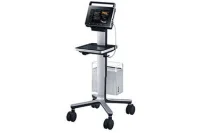Study results published in the current issue of British Journal of Urology International (10.1111/bju.12223) show that new software to register and fuse information from magnetic resonance imaging (MRI) and ultrasound (US) images enables intraoperative visualisation of tumors, not ordinarily seen in a US image. This technology has the potential to support new tissue-preserving treatments for prostate cancer, such as focal therapy.
In the study, "Image-Directed, Tissue-Preserving Focal Therapy of Prostate Cancer: a Feasibility Study of a Novel Deformable MR-US Registration System" researchers from University College London (UCL) evaluated the feasibility of using a computer-assisted, deformable image registration software to enable three-dimensional, multi-parametric MRI derived information on tumour location and extent to inform both the planning and treatment phase of focal high intensity focused ultrasound (HIFU) therapy using SonaCare Medical's Sonablate® 500 system.
This pilot study used computer assisted MRI-US image registration software within the planning of the first 26 men with a MRI-visible tumour treated at UCL with HIFU using a tissue-preserving quadrant, hemispheric (hemi) or extended hemi ablation therapy. Results showed that the software, developed at UCL, enables information of tumour location to be used for therapy planning using the Sonablate® 500 system without adding significant extra time to the standard procedural workflow. Such planning is particularly important for new tissue-preserving treatment approaches to ensure that the tumour is completely treated.
"Multi-parametric MRI has shown promise as an accurate method for determining the focality of tumours, and has promise as a potentially important enabler for minimally-invasive, tissue-preserving, or focal, HIFU treatments. However, most ablative technologies for localised prostate cancer use an ultrasound platform to plan and deliver treatment, on which the tumour cannot be accurately localised. This often results in discrepancies between the tumour and target volumes, potentially leading to under-treatment at the margins, or treatment of larger tissue volumes to compensate for inaccuracies in targeting," said lead author Louise Dickinson of UCL. "We are very pleased that the results of this pilot study demonstrate that deformable image registration is feasible and safe when introduced into a HIFU ablative therapy setting and suggests potential for improving the accuracy of targeting lesions using a tissue-preserving focal therapy approach."
Dr. Dickinson added: "Indeed, if on-going clinical trials demonstrate clinical utility for focal therapy as an alternative to current standards of care, it is possible that image registration software may be essential for the efficient implementation of truly focal therapy techniques in which individual tumors are treated within an appropriate and safe surgical margin. The use of MRI-US registration potentially provides a cost-effective solution that, as shown in this study, can be easily integrated within existing workflows and interfaces, using standard surgical equipment."
"The adoption of tissue preserving approaches for the treatment of prostate cancer has been hampered by limitations in diagnosing and localising clinically significant prostate cancers," said Mark Carol, M.D., Chief Development Officer for SonaCare Medical. "The publication of these results in the British Journal of Urology International is a tremendous validation of UCL's pioneering research in image registration and fusion technology that has led to significant advances in the validation and adoption of focal HIFU. We are proud to work with UCL to expand access to this breakthrough technology designed to enable targeted treatment of clinically significant prostate cancers."
SOURCE SonaCare Medical, Jul 25, 2013
Latest Articles
MRI, Ultrasound
Study results published in the current issue of British Journal of Urology International (10.1111/bju.12223) show that new software to register and fuse in...










